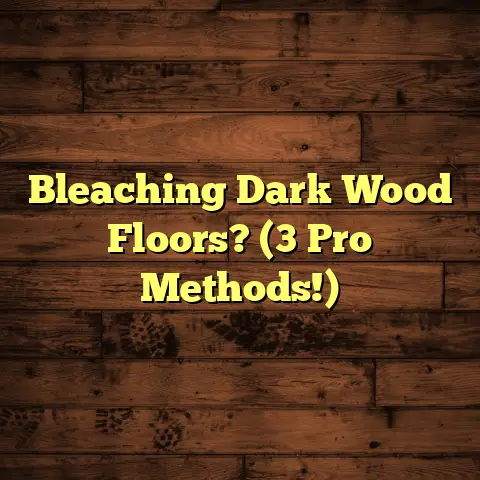Bed Sliding on Wood Floor? (1 DIY Solution!)
Discover the Ultimate DIY Solution!
Is your bed a runaway train on your beautiful wood floor? I get it!
If you dread the nightly struggle of pushing your bed back into place, you’re not alone!
Millions of homeowners face this frustrating issue, but few know that a simple DIY solution can save the day.
I’ve seen it all in my years as a flooring contractor: from minor annoyances to major floor damage caused by beds constantly shifting.
It’s more common than you think, and it’s definitely something you can tackle yourself.
So, let’s dive into why this happens and, more importantly, how to fix it!
Understanding the Causes of Bed Sliding
Wood floors are gorgeous, right? But that smooth finish, while aesthetically pleasing, is also the culprit behind your bed’s unwanted travels.
Think about it: a polished surface offers very little friction.
Different wood finishes play a role, too.
A high-gloss polyurethane finish, for example, is slicker than a matte, oil-based finish.
The smoother the finish, the easier it is for your bed to slide around.
And the type of wood matters as well.
Harder woods like maple or oak tend to be smoother than softer woods like pine.
Now, let’s talk bed frames.
Platform beds, with their wide, flat bases, often have more surface area in contact with the floor, increasing the potential for sliding.
Sleigh beds, with their curved legs, can also be unstable, especially if the weight isn’t distributed evenly.
Adjustable frames, while super convenient, can sometimes exacerbate the problem due to their segmented construction and potential for uneven weight distribution.
Weight distribution is key.
A heavy mattress and bedding can create a lot of downward pressure, but if that weight isn’t distributed evenly across the bed frame, it can lead to instability and sliding.
Think of it like this: if most of the weight is concentrated on one side of the bed, that side is more likely to slip.
The center of gravity plays a huge role here.
If your bed’s center of gravity is off-kilter, it’s going to be more prone to movement.
And don’t forget about environmental factors.
Humidity and temperature changes can affect wood flooring.
Wood expands and contracts with changes in humidity, which can alter the friction between your bed frame and the floor.
According to the National Wood Flooring Association (NWFA), maintaining a consistent humidity level in your home is crucial for preserving the integrity of your wood floors.
I’ve seen cases where seasonal changes alone were enough to turn a previously stable bed into a slippery menace.
The Impact of Bed Sliding on Your Home
Okay, so your bed is sliding.
It’s annoying, sure, but is it really a big deal?
Unfortunately, yes.
Let’s start with the obvious: damage to your wood floors.
A sliding bed can cause scratches, dents, and finish wear.
I’ve seen floors with deep gouges from bed legs constantly scraping against the surface.
Over time, this can lead to costly repairs or even the need for a complete floor replacement.
And it’s not just the surface that’s at risk.
The constant movement can also loosen floorboards or damage the subfloor underneath.
But the impact goes beyond just physical damage.
A disrupted sleep environment can have significant psychological and physical effects.
According to the American Academy of Sleep Medicine, a stable sleep environment is crucial for achieving restful sleep.
When your bed is constantly shifting and creaking, it can disrupt your sleep cycle, leading to fatigue, irritability, and even long-term health problems.
I’ve heard countless stories from clients who were losing sleep due to their sliding beds.
One client told me she felt like she was sleeping on a boat, constantly adjusting to the shifting of the bed!
And let’s not forget about the aesthetic concerns.
A misaligned bed can throw off the entire look of a room.
Furniture arrangement is a key element of interior design, and a bed that’s constantly out of place can disrupt the balance and harmony of your space.
I’ve seen rooms that looked otherwise perfect but were completely undermined by a bed that wasn’t properly positioned.
It’s like a crooked picture frame – it just doesn’t look right!
The Ultimate DIY Solution
Alright, enough with the doom and gloom.
Let’s get to the good stuff: fixing the problem!
What if I told you that with just a few simple materials, you could say goodbye to that sliding bed for good?
It’s true!
My go-to DIY solution is surprisingly simple and effective.
It involves using non-slip rug pads or adhesive grippers to create a buffer between your bed legs and the wood floor.
Here’s what you’ll need:
- Non-slip rug pads or adhesive grippers: These are the key to preventing slippage. I recommend getting ones that are specifically designed for use on hardwood floors. You can find them at most home improvement stores or online.
- Measuring tape: You’ll need this to measure the size of your bed legs.
- Scissors or a utility knife: For cutting the rug pads or grippers to size.
- Optional: Paint or stain for aesthetic purposes: If you want to get fancy, you can paint or stain the rug pads to match your bed frame.
Now, let’s get to the step-by-step instructions:
Step 1: Measure the bed legs and cut the non-slip rug pads or adhesive grippers to size.
Use your measuring tape to determine the dimensions of the bottom of your bed legs.
Then, use your scissors or utility knife to cut the rug pads or grippers to the appropriate size.
I recommend cutting them slightly larger than the bed legs to provide maximum coverage.
Step 2: Clean the bottom of the bed legs to ensure proper adhesion.
This is an important step!
Before you attach the rug pads or grippers, make sure the bottom of your bed legs are clean and free of dust, dirt, or any other debris.
You can use a damp cloth or a mild cleaning solution to wipe them down.
Allow them to dry completely before proceeding.
Step 3: Attach the non-slip pads, ensuring they are securely in place.
If you’re using adhesive grippers, simply peel off the backing and stick them to the bottom of the bed legs.
If you’re using non-slip rug pads, you can use double-sided tape or a small amount of glue to secure them in place.
Make sure the pads are centered on the bed legs and that they are firmly attached.
Step 4: Test the bed for stability and adjust as necessary.
Once the pads are in place, test the bed for stability.
Push and pull on the bed to see if it still slides.
If it does, you may need to add more pads or adjust their placement.
You can also try using a different type of non-slip material.
I’ve found that some materials work better than others depending on the type of wood floor and bed frame.
Here are a few tips for troubleshooting common issues during the installation process:
- If the rug pads or grippers are too thick, they can make the bed wobble. To fix this, try using thinner pads or trimming them down to size.
- If the adhesive isn’t strong enough, the pads may come loose over time. To prevent this, use a high-quality adhesive or consider using non-slip rug pads instead.
- If the bed is still sliding, even with the pads in place, you may need to add more weight to the bed frame. You can do this by placing heavy objects, such as books or weights, underneath the bed.
I know what you’re thinking: “Is it really that simple?”
Yes, it is!
I’ve used this DIY solution countless times with great success.
It’s a quick, easy, and affordable way to stop your bed from sliding on your wood floor.
Additional Benefits of the DIY Solution
Beyond just stopping your bed from sliding, this DIY solution offers a few other benefits.
For one, it’s incredibly versatile.
You can use the same non-slip rug pads or adhesive grippers on other furniture pieces, such as chairs, sofas, and tables.
I’ve even used them on my dining room chairs to prevent them from scratching my wood floor.
The solution is also adaptable to various floor types.
While it’s primarily designed for use on wood floors, it can also work on tile, laminate, and other smooth surfaces.
Just be sure to choose a non-slip material that’s appropriate for your specific floor type.
And let’s not forget about the cost-effectiveness of this DIY solution.
Compared to hiring a professional to fix the problem, this is a fraction of the cost.
You can buy a pack of non-slip rug pads or adhesive grippers for less than $20, and the entire project should take you less than an hour to complete.
Plus, there’s the satisfaction of knowing that you fixed the problem yourself!
Finally, this DIY approach is also more sustainable than many other solutions.
You can choose eco-friendly materials, such as recycled rubber or natural latex, to minimize your environmental impact.
By fixing the problem yourself, you’re also reducing the need for new furniture or floor repairs, which can further contribute to sustainable living practices.
Conclusion
So, there you have it: the ultimate DIY solution for stopping your bed from sliding on your wood floor.
I hope I have been able to reinforce the benefits of addressing the bed sliding issue.
I’ve seen firsthand how a stable bed can contribute to a better night’s sleep and protect the integrity of your wood floors.
It’s a simple fix that can make a big difference in your home and your well-being.
So, what are you waiting for?
Give this DIY solution a try and say goodbye to that runaway bed for good!
And don’t forget to share your experiences in the comments below.
I’d love to hear about your results and any additional tips you may have.
Let’s create a community of DIYers who are passionate about fixing problems and improving their homes!





